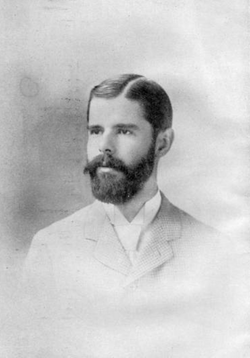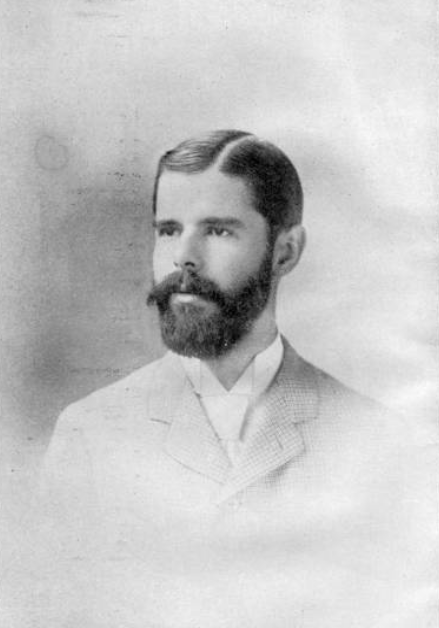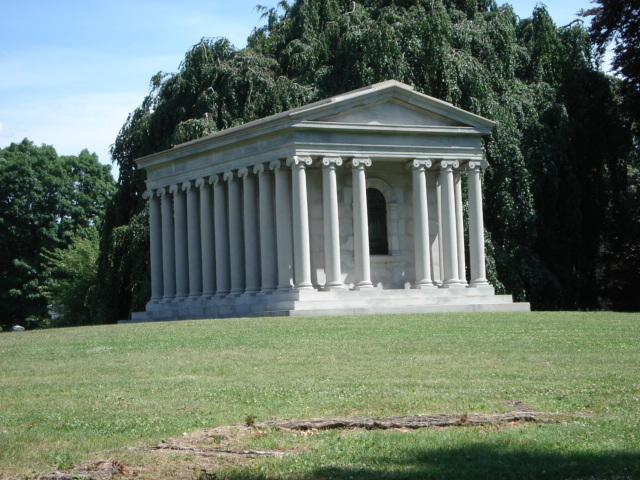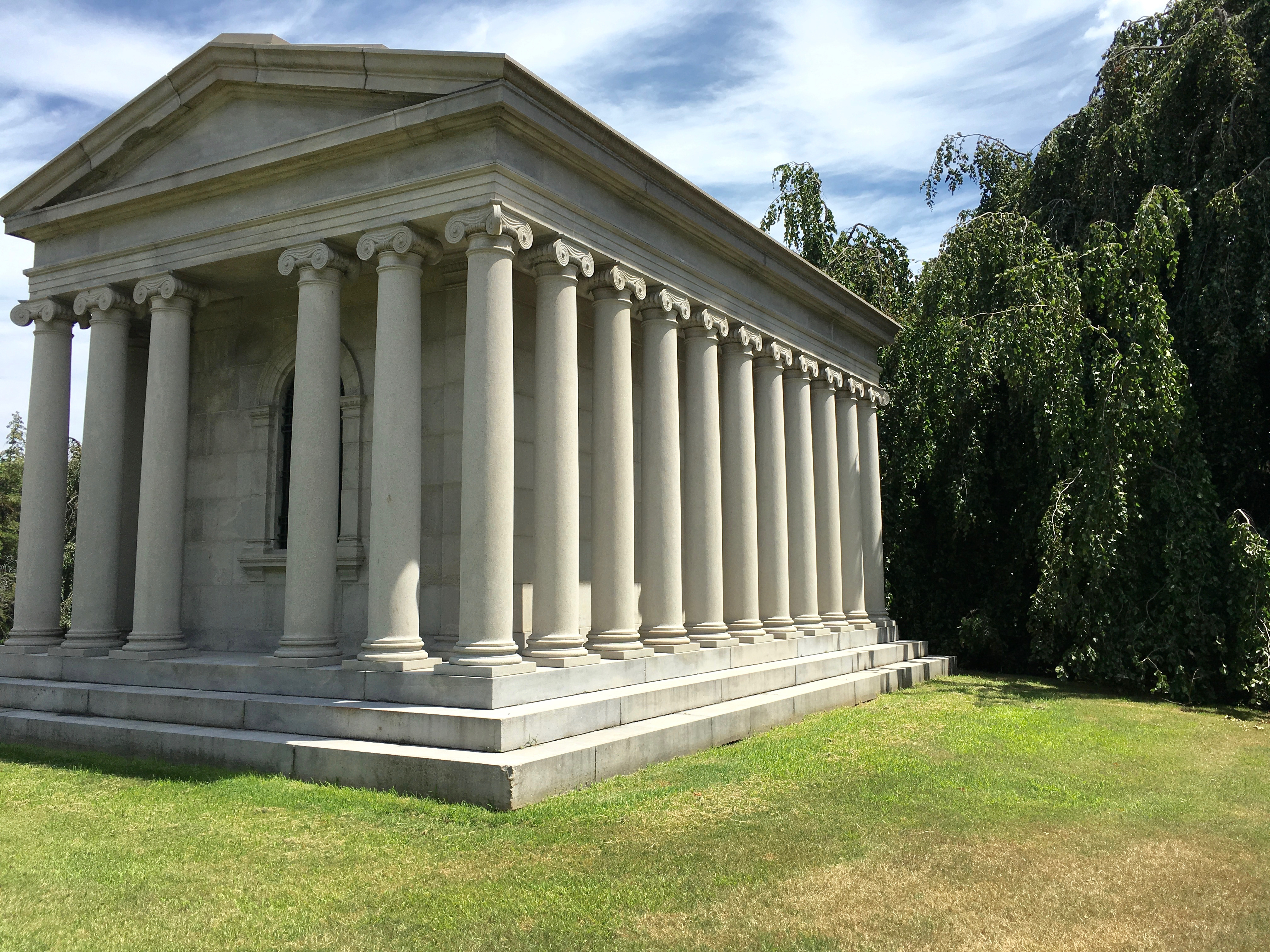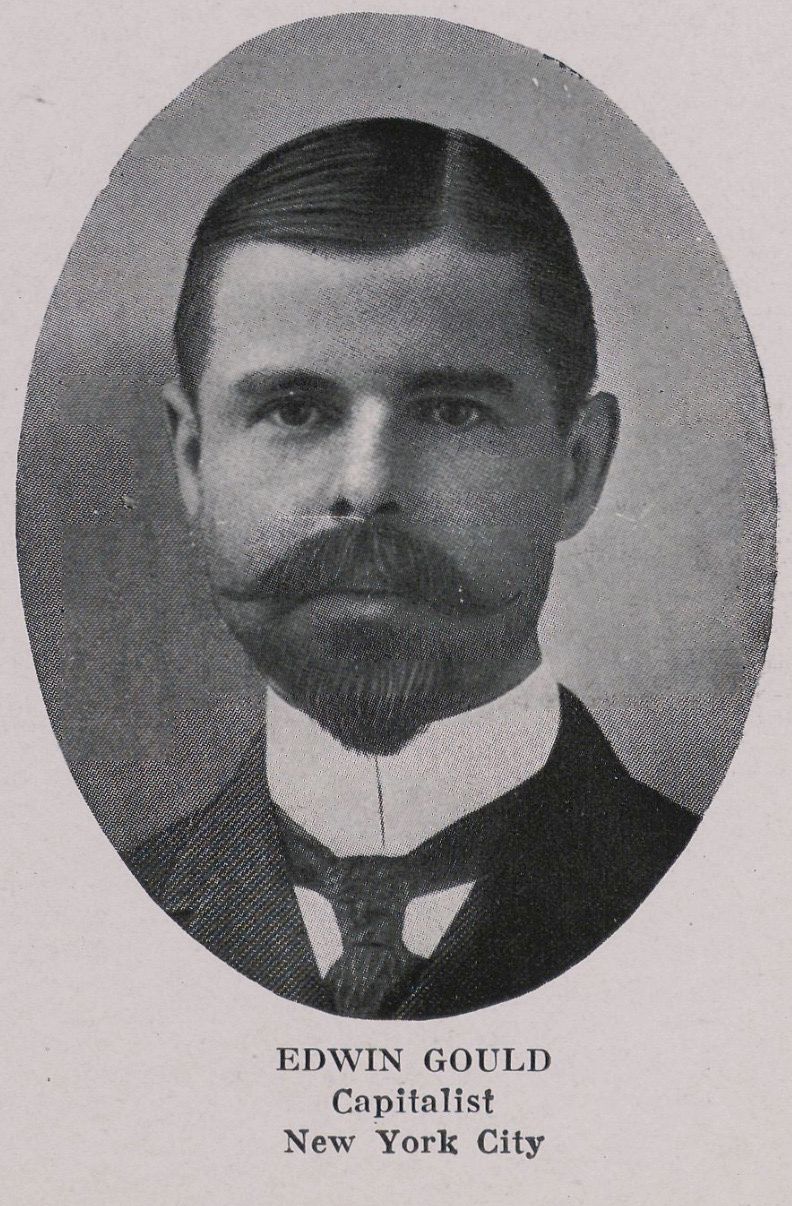Parents:
Son of Jay Gould (1836-1892) and Helen Day Miller (1838-1889).
Death:
Time magazine wrote on Monday, July 24, 1933: "Sublimed Gould In Oyster Bay, L. I. one evening last week Edwin Gould, 67, after a quiet game of bridge with wife and friends, went to his room, began to undress, suddenly cried out. Thus, as it must to all men, Death came—before his wife could reach his side —to the second son of famed Jason (Jay) Gould. Day later an announcement was inserted in the Manhattan Press: "With those 'forces for good' grief stricken at the death of Edwin Gould stands the Harlem Eye & Ear Hospital, thanking God for the life of ..."
Biography:
The following biography is from the foundation he created: "He was born into the wealthy family of Mr. and Mrs. Jay Gould. Jay Gould made his fortune on Wall Street and through ownership of several railroads. The family lived near Union Square in New York City and later relocated to Lyndhurst, Upstate New York. Edwin was one of six children. He attended Columbia University and although he passed all his courses, he evidently was not satisfied with school. So, after three years, he left Columbia without a degree. Because Jay Gould disapproved of his son's decision to leave school, he was not accepted into the family business. Therefore, Edwin set himself up independently as a broker and speculator on Wall Street. Within six months, he made more than a million dollars by speculating in railroads. His father was so impressed, that he asked Edwin to join the family's business. In 1892 Edwin Gould met and married Sarah Shrady and Jay Gould died. So at the age of 27, with an inheritance from his father's estate and the fortune that he made for himself, Edwin was worth twenty million dollars. Edwin and Sarah had two boys and the family maintained a quiet life in New York City. However, they had a particular fondness for an island off the coast of Georgia, so Edwin had a lodge built for the family on Jekyll Island. This became a favorite place to retreat with family and friends. Edwin was fond of his mother-in-law, Hester Shrady. Her work as a member of the board of managers of the Messiah Home for children impressed Edwin greatly. Hester Shrady donated a great deal of her time and substantial amounts of her wealth to the orphanage. Her efforts impressed Edwin and Sarah so much that they began making contributions of money, food and clothing to charitable organizations. The Sheltering Arms Children's Services was one of the first children's homes to which Edwin and Sarah made contributions. Agency's records show that Edwin Gould visited the home regularly and was known to the children and staff as the friend and benefactor who gave such treats and goodies, such as tickets to the circus and ice cream during the hot summer months. Although Edwin derived enormous satisfaction from his contact with the children at Sheltering Arms, it was not until tragedy struck his life that he became so entirely devoted to helping children. His son, Edwin, Jr. was accidentally shot while on a camping trip. At the funeral services, a large basket of roses arrived from the children of Sheltering Arms, one rose from each child at the home. This tender memorial so moved the bereaved father that he determined to devote his fortune and his time in their behalf. A decision that during the preceding sixteen years brought innumerable benefits to thousand of children inside and outside the United States – a much happiness to himself. The Lakeside School was the first program under Edwin Gould's direct administration. He also supported the Kingsland School for Boys, which was located in the Bronx, NY. Later he built the clearing bureau near Pelham Parkway in the Bronx to provide for Protestant children a period of quarantine, which was necessary at that time, before placement in long-term care. In 1923, through a special act of the New York Legislature, Edwin Gould established the Edwin Gould Foundation for Children to ensure that these services to children would not cease with his death. In 1939, six years after Edwin Gould's death, the Edwin Gould New York Fund was established as a separate corporation to operate the childcare programs of the Edwin Gould Foundation for Children". The following biography is from in the "History of the St. Louis Southwestern Railway" by Wayne E. Beck: "The year 1898 saw the passing from actual participation in the business of the company, one of its most ardent. leaders. On October 31, Samuel Fordyce relinquished his office to Edwin Gould after a service record of approximately twenty years. Fordyce's resignation was due chiefly to his differences with George J. Gould, who demanded that Fordyce turn over the business of the Cotton Belt in Texas and Arkansas at junction points to his Texas roads and to the Missouri Pacific, regardless of pre-established rate agreements. After another disagreement over the defeat of a railroad commission in Arkansas, Fordyce tendered his resignation. Edwin Gould, second son of Jay Gould, was first connected with the road in 1888 as secretary, and was elected vice president in 1891 during the reorganization. He was born on February 26, 1866, and attended private schools until he became old enough to enter Columbia University, where, after three years, he decided that his interests were more in the commercial lines than in the literary. Despite his father s refusal to give him permission, he left college and turned to Wall Street, where in six months his operations showed a profit of one million dollars. In 1925 he sold control of the Cotton Belt to the Rock Island Railroad, which terminated the connection of the Gould family as railroad operators in this country after more than sixty-eight years of having controlling interest in one or more railroads. He turned his attention to helping establish homes and foundations for underprivileged children. The most noteworthy of these were the Edwin Gould Foundation for Children, the Hopewell Society of Brooklyn, and the Berkshire Industrial Farms at Canaan, New York. When the United States entered the first World War, he served first as supply sergeant of Troop A, Squadron A, and later as major in the ordnance department of the First Brigade. During Edwin Could's administration the Cotton Belt substantially increased its earning capacity, and many changes, purchases, and additions were made."
Parents:
Son of Jay Gould (1836-1892) and Helen Day Miller (1838-1889).
Death:
Time magazine wrote on Monday, July 24, 1933: "Sublimed Gould In Oyster Bay, L. I. one evening last week Edwin Gould, 67, after a quiet game of bridge with wife and friends, went to his room, began to undress, suddenly cried out. Thus, as it must to all men, Death came—before his wife could reach his side —to the second son of famed Jason (Jay) Gould. Day later an announcement was inserted in the Manhattan Press: "With those 'forces for good' grief stricken at the death of Edwin Gould stands the Harlem Eye & Ear Hospital, thanking God for the life of ..."
Biography:
The following biography is from the foundation he created: "He was born into the wealthy family of Mr. and Mrs. Jay Gould. Jay Gould made his fortune on Wall Street and through ownership of several railroads. The family lived near Union Square in New York City and later relocated to Lyndhurst, Upstate New York. Edwin was one of six children. He attended Columbia University and although he passed all his courses, he evidently was not satisfied with school. So, after three years, he left Columbia without a degree. Because Jay Gould disapproved of his son's decision to leave school, he was not accepted into the family business. Therefore, Edwin set himself up independently as a broker and speculator on Wall Street. Within six months, he made more than a million dollars by speculating in railroads. His father was so impressed, that he asked Edwin to join the family's business. In 1892 Edwin Gould met and married Sarah Shrady and Jay Gould died. So at the age of 27, with an inheritance from his father's estate and the fortune that he made for himself, Edwin was worth twenty million dollars. Edwin and Sarah had two boys and the family maintained a quiet life in New York City. However, they had a particular fondness for an island off the coast of Georgia, so Edwin had a lodge built for the family on Jekyll Island. This became a favorite place to retreat with family and friends. Edwin was fond of his mother-in-law, Hester Shrady. Her work as a member of the board of managers of the Messiah Home for children impressed Edwin greatly. Hester Shrady donated a great deal of her time and substantial amounts of her wealth to the orphanage. Her efforts impressed Edwin and Sarah so much that they began making contributions of money, food and clothing to charitable organizations. The Sheltering Arms Children's Services was one of the first children's homes to which Edwin and Sarah made contributions. Agency's records show that Edwin Gould visited the home regularly and was known to the children and staff as the friend and benefactor who gave such treats and goodies, such as tickets to the circus and ice cream during the hot summer months. Although Edwin derived enormous satisfaction from his contact with the children at Sheltering Arms, it was not until tragedy struck his life that he became so entirely devoted to helping children. His son, Edwin, Jr. was accidentally shot while on a camping trip. At the funeral services, a large basket of roses arrived from the children of Sheltering Arms, one rose from each child at the home. This tender memorial so moved the bereaved father that he determined to devote his fortune and his time in their behalf. A decision that during the preceding sixteen years brought innumerable benefits to thousand of children inside and outside the United States – a much happiness to himself. The Lakeside School was the first program under Edwin Gould's direct administration. He also supported the Kingsland School for Boys, which was located in the Bronx, NY. Later he built the clearing bureau near Pelham Parkway in the Bronx to provide for Protestant children a period of quarantine, which was necessary at that time, before placement in long-term care. In 1923, through a special act of the New York Legislature, Edwin Gould established the Edwin Gould Foundation for Children to ensure that these services to children would not cease with his death. In 1939, six years after Edwin Gould's death, the Edwin Gould New York Fund was established as a separate corporation to operate the childcare programs of the Edwin Gould Foundation for Children". The following biography is from in the "History of the St. Louis Southwestern Railway" by Wayne E. Beck: "The year 1898 saw the passing from actual participation in the business of the company, one of its most ardent. leaders. On October 31, Samuel Fordyce relinquished his office to Edwin Gould after a service record of approximately twenty years. Fordyce's resignation was due chiefly to his differences with George J. Gould, who demanded that Fordyce turn over the business of the Cotton Belt in Texas and Arkansas at junction points to his Texas roads and to the Missouri Pacific, regardless of pre-established rate agreements. After another disagreement over the defeat of a railroad commission in Arkansas, Fordyce tendered his resignation. Edwin Gould, second son of Jay Gould, was first connected with the road in 1888 as secretary, and was elected vice president in 1891 during the reorganization. He was born on February 26, 1866, and attended private schools until he became old enough to enter Columbia University, where, after three years, he decided that his interests were more in the commercial lines than in the literary. Despite his father s refusal to give him permission, he left college and turned to Wall Street, where in six months his operations showed a profit of one million dollars. In 1925 he sold control of the Cotton Belt to the Rock Island Railroad, which terminated the connection of the Gould family as railroad operators in this country after more than sixty-eight years of having controlling interest in one or more railroads. He turned his attention to helping establish homes and foundations for underprivileged children. The most noteworthy of these were the Edwin Gould Foundation for Children, the Hopewell Society of Brooklyn, and the Berkshire Industrial Farms at Canaan, New York. When the United States entered the first World War, he served first as supply sergeant of Troop A, Squadron A, and later as major in the ordnance department of the First Brigade. During Edwin Could's administration the Cotton Belt substantially increased its earning capacity, and many changes, purchases, and additions were made."
Family Members
Sponsored by Ancestry
Advertisement
Advertisement
